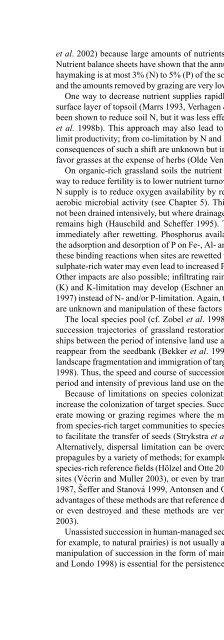Linking Restoration and Ecological Succession (Springer ... - Inecol
Linking Restoration and Ecological Succession (Springer ... - Inecol
Linking Restoration and Ecological Succession (Springer ... - Inecol
Create successful ePaper yourself
Turn your PDF publications into a flip-book with our unique Google optimized e-Paper software.
et al. 2002) because large amounts of nutrients have accumulated in the soil.<br />
Nutrient balance sheets have shown that the annual removal of N <strong>and</strong> P through<br />
haymaking is at most 3% (N) to 5% (P) of the soil nutrient pool (Bakker 1989),<br />
<strong>and</strong> the amounts removed by grazing are very low (Perkins 1978, Bakker 1989).<br />
One way to decrease nutrient supplies rapidly is to completely remove the<br />
surface layer of topsoil (Marrs 1993, Verhagen et al. 2001). This approach has<br />
been shown to reduce soil N, but it was less effective at reducing soil P (Marrs<br />
et al. 1998b). This approach may also lead to a shift in the nutrients which<br />
limit productivity; from co-limitation by N <strong>and</strong> P to limitation by N alone. The<br />
consequences of such a shift are unknown but indications suggest that it might<br />
favor grasses at the expense of herbs (Olde Venterink et al. 2003).<br />
On organic-rich grassl<strong>and</strong> soils the nutrient stocks are large, <strong>and</strong> the only<br />
way to reduce fertility is to lower nutrient turnover rates. One way to lower the<br />
N supply is to reduce oxygen availability by rewetting drained sites to lower<br />
aerobic microbial activity (see Chapter 5). This may work in sites that have<br />
not been drained intensively, but where drainage has been intense the N supply<br />
remains high (Hauschild <strong>and</strong> Scheffer 1995). This is also generally the case<br />
immediately after rewetting. Phosphorus availability is mainly controlled by<br />
the adsorption <strong>and</strong> desorption of P on Fe-, Al- <strong>and</strong> Ca-complexes. Alteration of<br />
these binding reactions when sites are rewetted with mineral-poor rainwater or<br />
sulphate-rich water may even lead to increased P supply (Lucassen et al. 2004).<br />
Other impacts are also possible; infiltrating rainwater can wash out potassium<br />
(K) <strong>and</strong> K-limitation may develop (Eschner <strong>and</strong> Liste 1995, van Duren et al.<br />
1997) instead of N- <strong>and</strong>/or P-limitation. Again, the consequences of such shifts<br />
are unknown <strong>and</strong> manipulation of these factors is not easy.<br />
The local species pool (cf. Zobel et al. 1998) is a second filter that affects<br />
succession trajectories of grassl<strong>and</strong> restoration. There are negative relationships<br />
between the period of intensive l<strong>and</strong> use <strong>and</strong> the degree to which species<br />
reappear from the seedbank (Bekker et al. 1997), <strong>and</strong> between the degree of<br />
l<strong>and</strong>scape fragmentation <strong>and</strong> immigration of target species (Poschlod <strong>and</strong> Bonn<br />
1998). Thus, the speed <strong>and</strong> course of succession are determined largely by the<br />
period <strong>and</strong> intensity of previous l<strong>and</strong> use on the site <strong>and</strong> in the surroundings.<br />
Because of limitations on species colonization, steps need to be taken to<br />
increase the colonization of target species. Successful methods included deliberate<br />
mowing or grazing regimes where the machines or animals are moved<br />
from species-rich target communities to species-poor restoration sites in order<br />
to facilitate the transfer of seeds (Strykstra et al. 1997, Mouissie et al. 2006).<br />
Alternatively, dispersal limitation can be overcome by deliberate addition of<br />
propagules by a variety of methods; for example, by adding fresh hay cut from<br />
species-rich reference fields (Hölzel <strong>and</strong> Otte 2003), adding top soil from donor<br />
sites (Vécrin <strong>and</strong> Muller 2003), or even by transfer of complete turfs (Klötzli<br />
1987, ˇSeffer <strong>and</strong> Stanová 1999, Antonsen <strong>and</strong> Olsson 2005). The obvious disadvantages<br />
of these methods are that reference donor sites are affected severely<br />
or even destroyed <strong>and</strong> these methods are very costly (Vécrin <strong>and</strong> Mueller<br />
2003).<br />
Unassisted succession in human-managed secondary grassl<strong>and</strong>s (in contrast,<br />
for example, to natural prairies) is not usually a tool of restoration. Continued<br />
manipulation of succession in the form of maintenance management (Bakker<br />
<strong>and</strong> Londo 1998) is essential for the persistence of seminatural grassl<strong>and</strong>s.<br />
Chapter 6 Manipulation of <strong>Succession</strong> 133

















